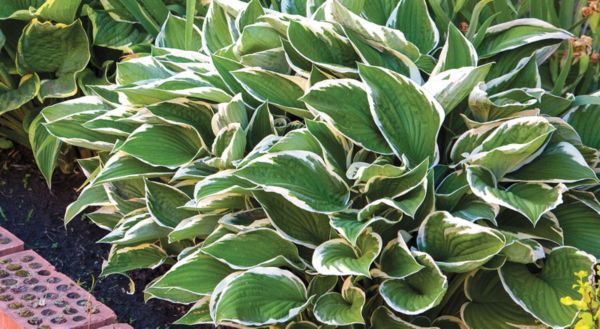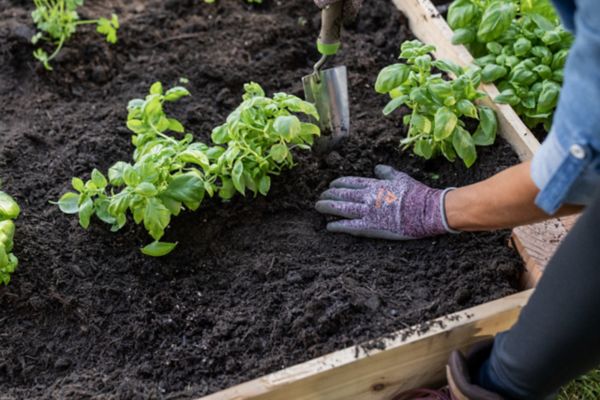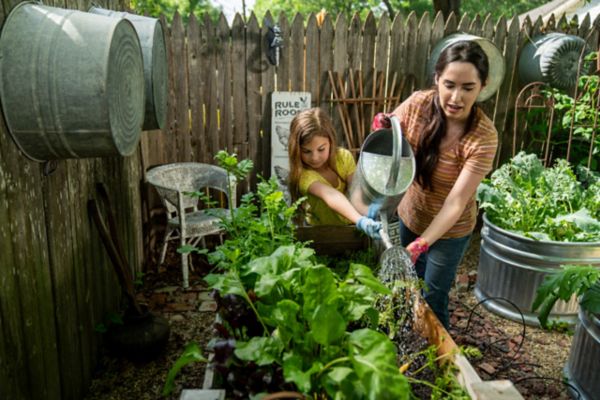How to Grow Rosemary
Authored by Leah Chester-Davis
This popular herb has escaped the confines of the herb garden and is also grown as a landscape plant in milder climates. Depending on the cultivar, it grows as a striking, tall, upright plant or as a prostrate or creeping form. It is also popular as a topiary.
Rosemary is one of the delights of any herb garden. It is a striking plant with an aromatic, pine-like scent, and thick, needle-like leaves. Often, the top sides of the leaves are a darker green and the undersides a grayish green or silvery color. The plant blooms with small pale blue, lavender, pink, or white flowers, depending on the variety.
Rosemary is easy to grow in either containers or garden beds. It originates in the Mediterranean and its Latin name, Rosmarinus, means dew of the sea, which refers to its native habitat. It thrives in coastal areas. There is also lots of lore and stories tied to this plant, many of which associate the herb with memories or remembrance.
Rosemary leaves, either fresh or dried, deliver wonderful flavor that enhances many culinary dishes. It pairs well with poultry, fish, beef, lamb, or pork. It is delicious with any roasted vegetable such as potatoes, sweet potatoes, squash, or tomatoes, and makes your house smell divine when you cook with it. It is a perfect herb to chop and add to soups, stews, stuffing, breads, sautéed or roasted mushrooms and to omelets or other egg dishes. It is often used in specialty vinegars or herb butter. The thick, sturdy stems of mature plants can be stripped of the leaves and used as skewers for kebabs to impart flavor to grilled foods.
About rosemary
| Botanical name: | Salvia rosmarinus; previously known as Rosmarinus officinalis |
| Common name: | Rosemary |
| Plant type: | Perennial evergreen shrub; tender perennial or annual in cold climates |
| Size: | Typically, 2 to 4 feet; up to 6 feet in its native Mediterranean region |
| Sun exposure: | Full sun |
| Soil type: | Well-drained, loamy |
| Soil pH: | 6 to 7 |
| Hardiness zones: | 7 to 10 |
| Average first frost: | Varies by region |
| Average last frost: | Varies by region |
| Container friendly: | Yes |
| Beginner friendly: | Yes |
Growing

Rosemary grows best in light, slightly acidic, dry to medium, well-drained soils in full sun. When established, it is drought tolerant. Rosemary is in the mint family. Plants in this family are often identified by square stems.
This plant is pretty throughout the year with its evergreen foliage and has added charm when it blooms with small flowers in different colors, depending on the variety. The blooms tend to be whorled around the stem. It typically blooms in spring and into the summer, and attracts bees, butterflies and hummingbirds.
Unlike many other herbs, rosemary Is quite hardy and can overwinter and even thrive when established in zone 7 and may be able to grow in zone 6 or 5 in the right warm spot with extra winter protection. Typically, in colder regions, where winter temperatures dip lower than 20 degrees F, it will likely need to be potted and brought indoors or to a protected location for the winter.
Unlike many other herbs, rosemary Is quite hardy and can overwinter and even thrive when established in zone 7.
Planting

Work the soil and incorporate about 4 inches of organic matter to a depth of about 6 to 8 inches. If you have had a soil test, follow recommendations. Rosemary typically does not need fertilizer added when planting.
Rather than starting from seed, it is best to start this plant with cuttings from a vigorous plant or with a small plant from your local garden center, which will be ready to harvest more quickly than plants grown from seed or cuttings. Most garden centers have plenty of rosemary to choose from in the spring, and that is the best time to plant.
If you have a friend who does not mind sharing a cutting or two from an established plant and you want to try starting your own, it is easy to do so. Simply clip a 4- to 6-inch branch from the stem of the plant, strip off the lower leaves about 2- to 3-inches up the stem. Plant in a 3-inch pot with a sandy potting mix or vermiculite. Water and place in a spot with indirect light. Water periodically as needed. It should root in about two months and will be ready to transplant into the garden.
If growing in a container, which may be best in climates where you plan to overwinter the plant indoors, use a quality potting mix and make sure the container has a drainage hole. Garden soil in containers becomes heavy and does not drain well. After danger of frost has passed in the spring, place the container outside. Give the plant a chance to acclimate to higher light levels and the sun intensity by placing it in a shaded area and gradually exposing it to more light over a few days. In cold climates, bring the plant indoors in late fall and before a heavy frost. Set it in a sunny, South-facing window to give it at least 6 hours of sunlight each day or use a grow light. Indoors, it does best in a cool, humid location. Water when the soil feels dry a half inch below the surface. When the container is outdoors, you may need to water more often, particularly on hot days. Empty any water in the saucer under the container to prevent problems with the roots.
Young plants may need to be watered every one to two weeks depending on the plant size and conditions. Check the soil and allow it to dry out between each watering. Too much water can cause root rot. When established, rosemary is quite hardy and drought tolerant and may need little water.
In zone 7 and up, rosemary usually thrives through the winter without any special attention; in cooler zones, it needs protection from winter winds and benefits from a sunny, sheltered location near the south or west side of the house. A 5- to 6-inch layer of wood mulch lends protection to the roots.
Fertilizing
Rosemary rarely needs fertilizer. If the foliage is pale yellow or the plant does not appear to be growing, apply an all-purpose fertilizer in early spring before new growth appears. Fertilize lightly; excess fertilizer reduces flowering and fragrance. Follow label directions and avoid getting fertilizer on the foliage. Water after applying.
- For rosemary grown in containers indoors, Minnesota Extension recommends a liquid fertilizer at half the label-recommended strength once every six weeks. For containers outdoors, the recommendation is every three to four weeks.
Controlling Pests, Diseases, and Other Problems
- Rosemary can be susceptible to powdery mildew, particularly in humid areas. Grow it in an area that has plenty of air circulation and is not overcrowded. Pruning overgrown plants helps improve air circulation. It can develop root rot if it is overwatered.
- This herb typically does not have a problem with insects outdoors. Indoors, watch for mealybugs, whiteflies, and spider mites. Cornell Extension recommends a soapy solution of 1 to 2 tablespoons of a mild dishwashing soap to one gallon of warm water. Spray infested plants once a week while pests are visible. If the solution is discoloring or otherwise affecting the leaves, decrease the amount of soap used. Wash leaves before using in a recipe.
- This is a plant that deer usually leave alone.
This is a plant that deer usually leave alone.
Harvesting and Storing

As rosemary grows, and particularly when it becomes 2 feet tall or more, it can be harvested many times throughout the season. Harvest no more than what you can use. Harvest herbs in the morning after the dew dries but before the mid-day heat, or during the evening after sunset.
If harvesting to dry, hang rosemary in bundles of five to six stems in a dark, dry, well-ventilated room. Tie the end of the stems together and hang upside down. It typically takes one to two weeks for the leaves to dry. Another method is to place on a screen for good air circulation to air dry it.
Storing
After harvesting rosemary, store in a glass of water for two to seven days on the kitchen counter or in a zip top bag in the refrigerator.
If you have dried the sprigs, strip the leaves from the stem. Store in an airtight container.
Harvest herbs in the morning after the dew dries but before the mid-day heat, or during the evening after sunset.
Expert Tips

- In Zone 7 and above, rosemary can grow quite large, up to 4 feet tall. When planting a small plant that comes in a 4-inch pot from the local garden center, place it in a warm, sunny spot in your landscape. Keep in mind the size it will be in just a few years and consider other plants you may want nearby. Rosemary is lovely in a mixed perennial bed. Its tall, columnar habit and deep gray-green foliage pairs well with many other perennials.
Frequently asked questions
Are there cold varieties of rosemary?
There are a few varieties that may be hardy to zone 6. A couple are ‘Arp’ and ‘Hill’s Hardy’. Check with your local garden center for these and other suggestions.
Will rosemary plants in the shape of Christmas trees grow outdoors?
These delightful plants certainly brighten up holiday décor. If you live in a temperate climate, they can even be set outside as decoration or planted outdoors in a protected area. In colder climates, even though the tag may say the plant will thrive in temperatures to 10 or 20 degrees, it may be best to enjoy them indoors. They likely have been grown in a greenhouse environment, come in a small container, and may not do well outside in the winter. If you wish to keep it indoors during the winter, consider repotting into a larger container with a good potting mix. Place in a sunny window in a room that is cool with some humidity. Keep it watered but not waterlogged. Growing rosemary indoors can be a challenge but if it is still pretty come springtime, plant it outdoors.
What is best way to increase humidity when I bring my plants indoors?
One way is to set your container in a pan of moist pebbles. Since rosemary needs good air circulation do not crowd it with other plants.






